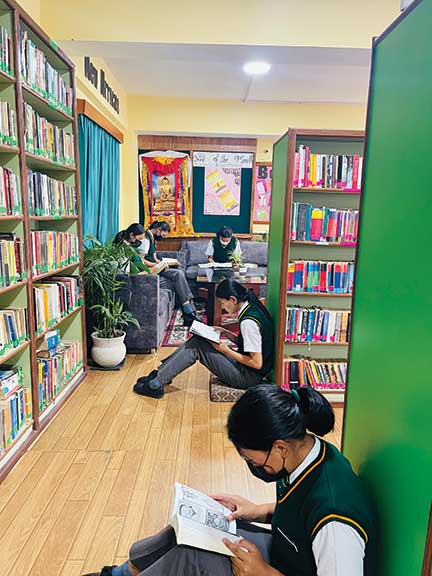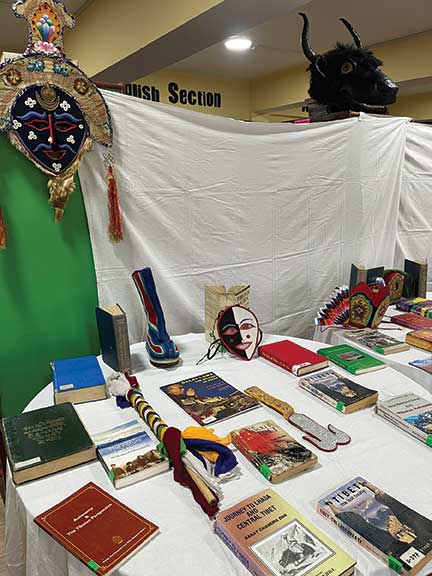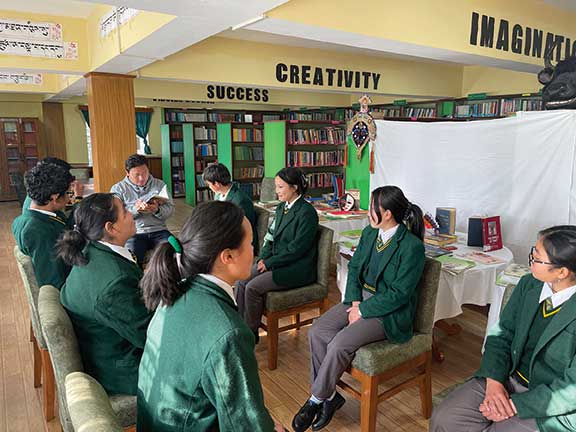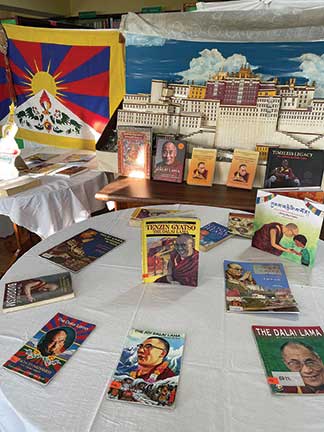Jangchup Nyingpo
The library educator and the context
My name is Jangchup Nyingpo and I am a librarian. I am a Tibetan in exile. I did my graduation from M.S University, Baroda, in Geography (Hon) and later acquired a BLisc. and MLisc. (Master in Library and Information science) degree followed by a PGDLAN (Post-Graduation Diploma in Library Networking and Automation) and recently I completed my LEC (Library Educator Course) from Bookworm, Goa.

I have worked at the Tibetan Children’s Village school (TCV) for almost ten years and am currently working with the Tibetan Homes Foundation, Mussoorie for the past five years as the Senior Librarian. Being a librarian means everything to me as you may have guessed from the many degrees that I have pursued and especially being a school librarian makes me very happy. A school librarian is not only responsible for the daily operations of a library but needs to also motivate young readers to interact with books, spend quality time with them and enjoy the ambience of the library.
Libraries play an important role in shaping the lives of children at an early age. In this context, many of my young readers believe that they will have superpowers if they read many books. For instance,on reading Matilda by Roald Dahl, children believed they too will gain superpowers although the protagonist Matilda is a fictional character. I enjoy being part of this magic.
A library is a place where you can find everything. In my library, readers come with complications in their lives, so as a librarian, I suggest books that they can read. Want to prepare for an exam, wait, I have a book. Do you want to be a doctor, wait, I have books for that. You can’t concentrate, wait, I have books for that too! You look sad and depressed, don’t worry, I have a book for that as well. S.R Ranganathan truly said in his second law of library science: Every reader his/her book. However, bringing children into the library and introducing any kind of collection to them is not an easy task.
The project
I used to have some displays in the library but they did not seem effective. However, while doing my LEC course I learnt about Thematic Displays and that was something new for me. I was curious, excited and wished to learn more about this approach. My mentor Thejaswi Shivanand, we call him Theju, helped me a lot to understand more about thematic displays, the how, the why and the where and this helped me decide to do my field project on Thematic Displays.

As I began this project in my library, I saw a change in the borrowing patterns of the students and their relationship with books. Therefore, here I would like to share how and what I did on this field project and my observations. I worked with 12 student volunteers from our school. I used material for the displays that went beyond the books such as toys, objects and other handmade items. I planned three thematic displays and collaboratively the students planned the fourth display.
As librarians our prime objective is to familiarize students with all parts of the library collection specially those sections that they are not familiar with. My intention was to show the students the richness of the library which had books in different languages (Tibetan, English, and hindi) and provide them with different kinds of books, so that they can explore the world through it. I felt that this activity would also help them to develop their book selection skills which may otherwise be unknown or hidden within themselves. I also imagined that the thematic display would help children get to know different genres of books and identify their preferences in reading. I felt that as part of an activity they can even recommend their reading to other friends. It will hopefully and inevitably lead to borrowing more books of different genres from the library.
The process
In an article by Sujata Noronha “Learnings from Displays” she mentions that “It was a collaborative display and everyone learnt in the process. This can very easily become a process for all our Displays, anywhere….” (Noronha, S. 2020). As I know that choosing the right book for a reader is also a difficult task, I paid careful attention to the group’s age, grade and interest. I took the help of a colleague and we also decided to select graphic novels as much as we could to attract more readers as we knew that our children are attracted to this format.
I set up the first three displays with the support of a colleague. However, the process for each display was observation, diary writing (by me) and conversations with the children after school hours. All children consented to participate in this project and were willing to stay after school hours and showed interest and excitement in my learning.
I identified the themes by talking to the children, reviewing their lending cards to understand their interests and came up with three themes.

Theme 1: Tibet
Since we are a community in exile, we have a deep purpose to read and understand our home country. The children responded to this display with passion. From an average of around seven books in the year on this theme, they read almost 25 books in just one week!
Theme 2: His Holiness the Dalai Lama
Besides continued positive borrowing on this display as it relates greatly to our community, the type of book was a big learning for the students. We have a number of graphic books on His Holiness and during our feedback session with children I learnt that children didn’t know that books on His Holiness were also available in comic/graphic form so they were excited to see those books and borrowed them.
Theme 3: Animal Books
Again, I noticed an inclination and increase in the number of books borrowed in a year after the week of the display. From about 15 books, as many as 54 books went out. One understanding I got was about the display itself. Animal books were kept at the bottom of the shelves in my library and so children would hardly reach for them or bend to look at them. Placing those books on the upper shelves and at eye level through a thematic display made the books visible and more attractive.
Theme 4: Folk Tales
The last thematic display was done by the students themselves. They also invited teachers and other school staff to visit the library for their display and to get some feedback about it. The students’ reason for this theme was because they felt most of them had not explored this genre before. In doing this display, they explored the collection actively and also procured books from the Junior Library.

The learnings
To enable the displays to be done, the library was kept open after school hours and on holidays. This, I learnt, helped the children connect more as they could come at their own time.
The children felt they were a part of the displays as I had shared my purpose with them and they too made their own display and were proud of it.
Books that were lying on the lower shelves or those that were forgotten were brought out and different genres of books were showcased.
Borrowing increased and the children’s relationship with me also became better. Library cards were dutifully maintained and became something that all of us were interested in and proud of.
I feel confident that the use of thematic displays has a great role to play in the library. Moreover, I have done many thematic displays even after completion of my field project at the LEC course. I have done themes on Horror, Mystery and Environment. I have also listed out themes for the new year in collaboration with my students and I am confident and assured that no books in the library will go unnoticed. When I do a thematic display, it is like a celebration in our school and many teachers bring their students to the library to enjoy our well set-up displays and suddenly the library is at the heart of the school. Lastly, as I said, for me, being a librarian is everything but I understood the true meaning of a librarian after I did my library educator certificate course.
The author is a Tibetan librarian at Mussoorie Homes Foundation, Mussoorie, Uttarakhand. He can be reached at jhangchup23@gmail.com.
